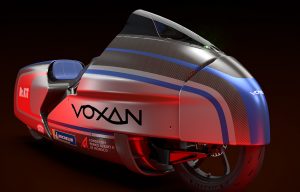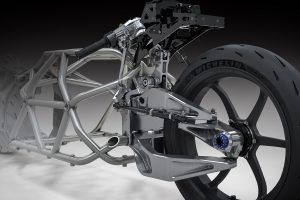If you’re attempting to establish a land speed record on a motorcycle, optimizing the physical conditions won’t garner any grief at breakneck. So in July 2021, the Voxan Wattman obviously won’t have any traffic to dodge or dead- end signs to ignore. An endless salt flat opening its road, drag heavy front breaks will be left behind, and the extra slack will let loose when the needle hits 330Km/h. But pulling out all the stops requires much more than just loading up on the acceleration.
“So we focused on two main points: drag and stability at high-speed,” said Louis- Marie Blondel, who oversaw the project’s development.Warp speed was far from the starting point, though. Set in place, wind tunnel and computer simulations tested the aerodynamics and helped gauge Wattman’s stability at high speeds. 240km/h was the maximum blowback that the technology allowed, but 90km/h shy, still provided plenty of data. However, the deficit left engineers navigating “uncharted territory,” so the process had to go on the move.
The test track got its fair share of mileage and confirmed Voxan’s two point agenda—especially in consideration of the low-grip track. “The slightest deviation can have very significant implications for stability. That’s why the design and aerodynamic profile of the motorcycle are so important,” said Franck Baldet, the project’s technical director. In response, the distance between the front and rear wheels was maximized. So instead of a telescopic fork, a double-wishbone front suspension was employed, and the lay of the land secured by a longer wheelbase. Additionally, both sides of the spokes were left clear—reducing the drag in a very practical manner.
A link and a swingarm don’t complicate the steering either. The rider set back and center of gravity lowered, the record run will slow on the rear brake and easily turn the corner. Voxan did the same in 2010 when Gildo Pastor purchased the company. President of Venturi, the new boss brought his high-performance electric vehicle mindset to Voxan and altered 15 years of manufacturing combustion vehicles such as Roadster, Cafe Racer, Scrambler and Charade Racing. The collaboration began zeroing in on change, and an incubator like setting begot Voxan’s drive to eliminate emissions at record speeds. So obviously Voxan’s pace won’t ever cool its heels. On the other hand, beating the motor heat comes without a radiator and the drag that goes with it. Instead, fluids are cooled by a dry ice tank and pumped through the powertrain.
Of course, all the svelte doesn’t get the record book up to speed unless the propulsion fires on all cylinders. The Venturi Group knows the drill from headquarters in Monaco and lets its track record provide the lead in. The Venturi VBB-3 holds the world record for an electric vehicle at 576 km/h, while the company has become the first team committing to the new all-electric Formula E Championship. The expertise has also supplied the powertrain to the HWA RaceLab team, and the high powered technology serves as the basis for the Wattman’s 270 kW engine. “We have poured all of the Venturi Group’s accumulated experience into this motorcycle world speed record project.
It has proved valuable, particularly for the process of optimizing the Wattman’s electronics, which we have had to develop completely, whether in terms of energy management or power management,” explained Baldet, who was also the Formula E Engineer for Venturi.
The same start from scratch baseline goes for providing enough juice to get out of the gate. Amassing 50% of the motorcycle’s weight, battery performance requires something more if the salt is going to be left in the dust. “There was simply no battery on the market that fit the bill,” Voxan declared. So the professionals got a jump on the problem by partnering with Venturi North America, and with the help of affiliated engineering students at Ohio State, the curriculum tested the world’s most powerful cells. Beating the curve, Monaco accepted the charges and endeavored to find the best possible power- to size ratio. 1470 cells later, the battery weighs in at 140kg and yields 317 kW of nominal power. The accelerated leap forward doesn’t require a custom grip below, and Voxan is sure that Michelin Pilot RS+ will hold tight. 190x55R17 on the rear wheel, and 120x70R17 at the fore, the choice amounts to more than off the rack, though. Test benches normally used for aircraft tires demonstrated that speeds of up to 450 km/h can be withstood. So when the odometer hits 330, any burning rubber will be held at bay. Of course, when the smoke clears next year, the 2700 mm blur could be missed in the blink of the eye. But the vision of Gildo Pastor and his engineers will be clear, and the sight will signify a historic pillar.
MORE Lifestyle STORIES
Get an inside vue on the latest in luxury. You heard it here first.






